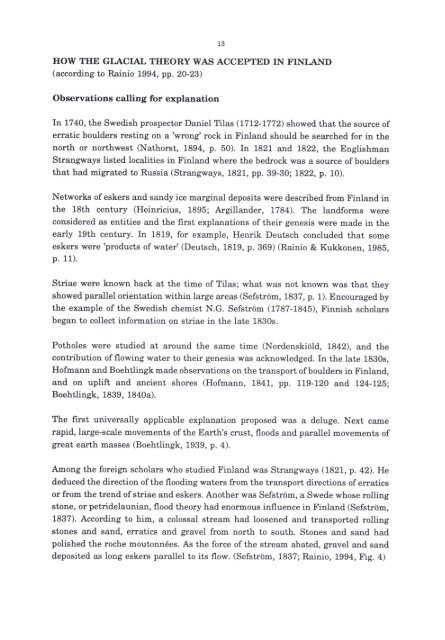DEGLACIATION IN EASTERN AND CENTRAL ... - arkisto.gsf.fi
DEGLACIATION IN EASTERN AND CENTRAL ... - arkisto.gsf.fi
DEGLACIATION IN EASTERN AND CENTRAL ... - arkisto.gsf.fi
Create successful ePaper yourself
Turn your PDF publications into a flip-book with our unique Google optimized e-Paper software.
13<br />
HOW THE GLACIAL GI.,ACIAL THEORY THEORYWAS WAS ACCEPTED ACCEPTED <strong>IN</strong> F<strong>IN</strong>L<strong>AND</strong> F<strong>IN</strong>I.<strong>AND</strong><br />
(according to Rainio 1994, pp. 20-23)<br />
Observations calling for explanation<br />
explanation<br />
In 1740, the Swedish prospector Daniel Daniel Tilas (1712-1772) showed that the source of<br />
erratic boulders resting on a 'wrong' rock in Finland Finland should be searched for in the<br />
north or northwest (Nathorst, 1894, p. 50). In 1821 and 1822, the tLLe Englishman<br />
Strangways Strangways listed localities localities in Finland where the bedrock was a source of boulders<br />
that had migrated to Russia Russia (Strangways, 1821, L82L, pp. 39-30; 1822, p. 10).<br />
Networks of eskers eskers and sandy ice marginal marginal deposits were described from Finland in<br />
the 18th century (Heinricius, 1895; 1895; Argillander, Argillander, 1784). 1784). The landforms landforms were<br />
considered as entities and the the <strong>fi</strong>rst frrst explanations of of their genesis were made in the<br />
early 19th century. In 1819, for 1o" example, elample, Henrik Henrik Deutsch Deutsch concluded that some<br />
eskers were were'products 'products of water' watef (Deutsch, 1819, p. 369) (Rainio & Kukkonen, 1985, 198b,<br />
p. 11).<br />
Striae were known back at the the time time of Tilas; rilas; what what was not not known known was that they<br />
showed parallel orientation within large areas (Sefström, 1837, 1837, p. p. 1). Encouraged by<br />
the example of the Swedish chemist chemist N.G. N.G. Sefström (1787-1845), Finnish Finnish scholars<br />
began began to collect collect information on striae striae in in the the late late 1830s.<br />
Potholes Potholes were studied at around the the same seme time (Nordenskiöld, 1842), and the<br />
contribution of flowing water to their their genesis genesis was was acknowledged. In the late 1830s,<br />
Hofmann Hofmann and Boehtlingk Boehtlingk made observations on the transport of ofboulders boulders in Finland,<br />
and on uplift and ancient shores (Hofmann, 1841, 1841, pp. 119-120 and 124-125; 124-L25;<br />
Boehtlingk, 1839, 1839, 1840a). 1840a).<br />
The frrst <strong>fi</strong>rst universally applicable explanation proposed was was a adeluge. deluge. Next came<br />
rapid, large-scale large-scale movements of the the Earth's Earth's crust, floods floods and parallel movements of<br />
great earth masses masses (Boehtlingk, 1939, p. 4).<br />
Among the the foreign scholars who studied Finland was Strangways (1821, (1821, p. 42). He<br />
deduced the direction ofthe of the flooding waters from the transport directions of erratics<br />
or from the trend of striae striae and eskers. Another was Sefström, a Swede whose rolling<br />
stone, or petridelaunian, flood theory theory had enormous influence in Finland (Sefström, (Sefström,<br />
1837). 1837). According to him, a colossal stream stream had had loosened and transported rolling<br />
stones and sand, erratics erratics and gravel gravel from north north to south. Stones and sand had<br />
polished the the roche moutonn6es. moutonnees. As the the force ofthe of the stream abated, gravel gravel and sand<br />
deposited as long eskers parallel to its flow. (Sefström, 1837; Rainio, 1994, Fig. 4)

















